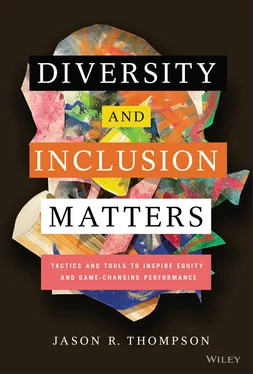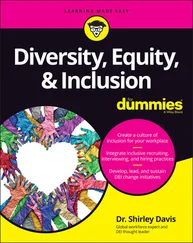Jason R. Thompson - Diversity and Inclusion Matters
Здесь есть возможность читать онлайн «Jason R. Thompson - Diversity and Inclusion Matters» — ознакомительный отрывок электронной книги совершенно бесплатно, а после прочтения отрывка купить полную версию. В некоторых случаях можно слушать аудио, скачать через торрент в формате fb2 и присутствует краткое содержание. Жанр: unrecognised, на английском языке. Описание произведения, (предисловие) а так же отзывы посетителей доступны на портале библиотеки ЛибКат.
- Название:Diversity and Inclusion Matters
- Автор:
- Жанр:
- Год:неизвестен
- ISBN:нет данных
- Рейтинг книги:3 / 5. Голосов: 1
-
Избранное:Добавить в избранное
- Отзывы:
-
Ваша оценка:
- 60
- 1
- 2
- 3
- 4
- 5
Diversity and Inclusion Matters: краткое содержание, описание и аннотация
Предлагаем к чтению аннотацию, описание, краткое содержание или предисловие (зависит от того, что написал сам автор книги «Diversity and Inclusion Matters»). Если вы не нашли необходимую информацию о книге — напишите в комментариях, мы постараемся отыскать её.
Diversity and Inclusion Matters: Tactics and Tools to Inspire Equity and Game-Changing Performance,
Diversity and Inclusion Matters
Diversity and Inclusion Matters — читать онлайн ознакомительный отрывок
Ниже представлен текст книги, разбитый по страницам. Система сохранения места последней прочитанной страницы, позволяет с удобством читать онлайн бесплатно книгу «Diversity and Inclusion Matters», без необходимости каждый раз заново искать на чём Вы остановились. Поставьте закладку, и сможете в любой момент перейти на страницу, на которой закончили чтение.
Интервал:
Закладка:
Source: United States Olympic & Paralympic Committee.
The USOPC had made a commitment to DE&I, but they didn't know where or how to start. I built Diversity Scorecards to show the diversity of every NGB within the USOPC and compared them against one another in a way that also valued the uniqueness of each sport.
This simple way of framing DE&I around recruitment and retention meant everyone had usable data, and it helped them understand what needed to be done. By having the demographic data in an easy-to-digest format about the employees and where they were in the company by department and level, the US Olympic and Paralympic Team leaders had a good understanding of the company's needs for recruitment and retention. Therefore, we set up programs and priorities that could be successful. We identified where we needed recruitment (diversity) efforts and where we needed retention (inclusion) efforts.
One of the successes of using the Diversity and Inclusion scorecards while I was at the United States Olympic and Paralympic team was that I was able to quickly show the CEO that the organization had a lack of diversity at the director level and above. In response to this, I created and implemented a program to increase diversity. It was designed so that hiring managers could quickly understand that they needed to interview four candidates, two of whom needed to be women or People of Color, and by doing so the odds of hiring a woman or Person of Color was 50%. It created no advantage for any one candidate. ( Chapter 6has a more detailed explanation about this process, which I call the 4-2-50 program.) This simple approach to recruitment leveled the playing field because it helps hiring managers overcome bias. At USOPC, the outcome was a threefold increase in the hiring of women and People of Color at the director level or above. This was well received because I was able to identify the problem and provide a specific solution, using the CAPE approach of collect, analyze, plan, and execute.
Another example of the power of the Diversity and Inclusion Scorecards was a time when I sat down with the person tasked with DE&I for the US Soccer Federation. This person had been with US Soccer for many years, but they were not a DE&I professional and had been given the responsibility of US Soccer's DE&I program as a project. The person was feeling very overwhelmed and said to me, “There's no way we could be successful because look at USA Basketball, we are never going to get there!” My response was, “Being like USA Basketball should not be your goal. USA Basketball is an example of over-representation. There are a lot of Black/African Americans but no Asians, no Latinx, and too few women on the staff.” I showed them the US Soccer Diversity Scorecard and said, “This will help you set goals and identify the best use of your time. You can't fix everything at once. You have limited resources and bandwidth. Pick a recruitment or retention effort and build a plan for your organization.” When I made this suggestion, I could see the relief on their face because now they could see how to develop a specific plan with measurable outcomes that could be shared with the leadership team.
Surveys and Their Limitations
Surveys are commonly used to support employee retention efforts. They are easy to administer and quickly yield data regarding employees' feelings on a myriad of subjects. Many companies frequently use this tool, but I would argue that the results are often an illusion, inaccurate, and not a good indication of how the company should move on important matters for underrepresented employees.
The biggest reason surveys are not helpful is that they are based on majority rule and that by definition is biased against underrepresented groups.
What company will change their approach or their culture based on a small percentage of responses? Nobody does that. But if you think about it, you can have several departments that have one Person of Color or one woman, and if nine people love whatever policy you are polling, and one person hates it, you won't change it because it looks like 90% of people like it.
If you have four People of Color and all of them say they hate the policy or are unhappy with the manager based on that person's behavior toward them, but the other six people are happy, you still have 60% of satisfied workers. There is also the question of trust. If you are the only African American in a department and you are treated poorly, you know it would be a risk to put that in an anonymous survey. If you don't trust your manager or leadership team, you won't be honest on a survey because any negative response will be attributed to you. No one will give honest answers if they feel their direct manager will know who gave them critical scores.
If the interpretation of the survey is always based on majority rule, when you have a few People of Color, or other marginalized groups, their voice through the survey is fundamentally minimized. To overcome bias, what most companies do is try to protect the anonymity of the respondents by taking extraordinary measures. So, let's look at the same example: We have ten employees. One person says they don't like the policy you are polling, that gives you one out of ten. That's 10%. But you can't use that data or share it with the leadership team because they would immediately know the respondent in question was a Person of Color, LGBTQ+, and so on. So, what do you do? One strategy many companies use is to combine their responses with another department, a larger department. So, let's combine, for example, marketing with accounting. Therefore, it helps keep the results anonymous. Seems like that would work, right? Wrong. The problem is, if you put them in with accounting, which has twenty employees including three People of Color who are all happy with the policy, you have the same problem. You've just taken somebody who was 10% of a group, put them in a larger group, and now their vote is only 3%. It's actually decreased in importance. You have less reason to do any actionable things, because, guess what, nobody makes changes in policy or procedures or work culture, if you have 97% approval. There's no reason to change, and the only way this process of combining departments works is if all the members of the underrepresented group have the same opinion or response in the survey.
Not only that, you've now confused the data because you put the one Person of Color in another department. So how do you know which manager to deal with? You don't, because you keep combining department results into bigger and bigger datasets. This makes it hard to train the right person because you've promised everybody that the survey is anonymous. Therefore, efforts to keep surveys anonymous make the responses from underrepresented employees less statistically significant. The minute you show up and say, People of Color are not happy, and there's only one Person of Color, everybody knows who it is. The only way you can address their concerns using surveys is to violate any promise of anonymity.
All three of these issues make survey data difficult to act on. Generally, if you say, “The survey shows that there's a problem in the accounting department,” the accounting manager's response will typically be: What is the issue? Who has a problem? Can I see the surveys? By and large, you can't answer those questions or share the surveys, so it makes it very difficult for you to effectively execute on initiatives related to survey responses. Additionally, the leader of the accounting department could rightly point out that 90% their department is happy. Once you share specifics about the 10% who are unhappy, any leader will quickly figure out who those people are, meaning the survey is no longer anonymous.
For these reasons, it is important to understand how surveys can actually work and why many times they can undermine your efforts. Employees often feel particularly frustrated by surveys. They think, I tell you every year what's wrong, and you do nothing about it . The reason you cannot do anything about it is because surveys are anonymous, which makes it difficult for you to present a real picture of the problem. This is why I don't recommend using surveys, because small groups of people will never have their concerns validated or changes made in order to improve employer/employee relations.
Читать дальшеИнтервал:
Закладка:
Похожие книги на «Diversity and Inclusion Matters»
Представляем Вашему вниманию похожие книги на «Diversity and Inclusion Matters» списком для выбора. Мы отобрали схожую по названию и смыслу литературу в надежде предоставить читателям больше вариантов отыскать новые, интересные, ещё непрочитанные произведения.
Обсуждение, отзывы о книге «Diversity and Inclusion Matters» и просто собственные мнения читателей. Оставьте ваши комментарии, напишите, что Вы думаете о произведении, его смысле или главных героях. Укажите что конкретно понравилось, а что нет, и почему Вы так считаете.











